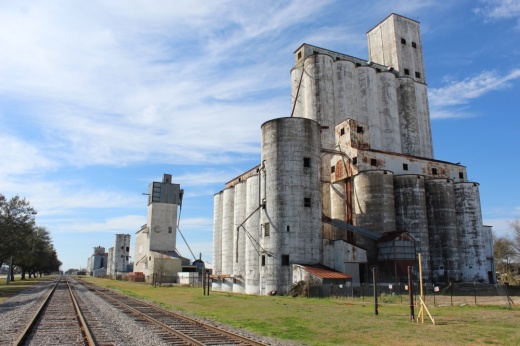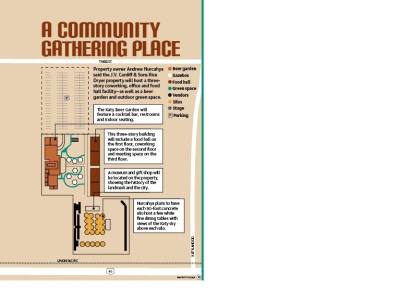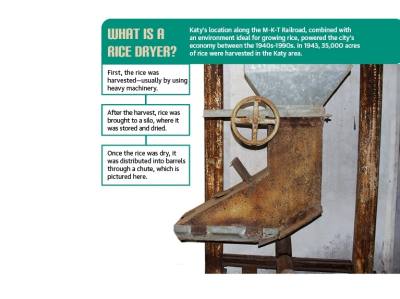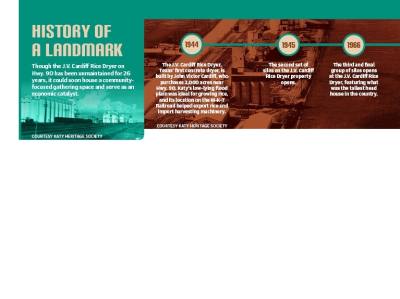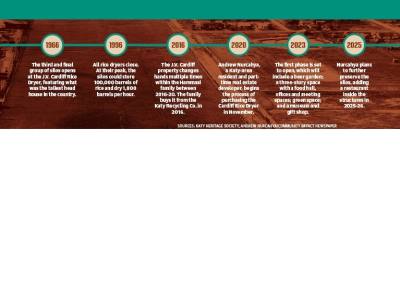In late 2020, developer Hadi “Andrew” Nurcahya bought the property from an Austin-based developer. Nurcahya said he plans to turn the site into a community-centric gathering space that aims to encourage local economic growth in alignment with historical preservation.
While numerous developers have tried to invest in the property, none of those projects moved forward. However, Nurcahya, a Katy-area resident and part-time real estate developer, became the latest investor of the property in November 2020—and local officials said they are hopeful the project is in the right hands this time.
“This is a historic building,” Nurcahya said. “I don’t know how, but we somehow got a hold of it—and now we’re going to [preserve it] as much as possible. We’re not going to try to change it. We’re going to work around it and respect it.”
When complete in 2023, the 3-acre property will include a Katy history museum backed by the Katy Heritage Society, a food hall featuring local restaurants, a beer garden, green space with a playground, a vending area for small-business owners to sell their products and a coworking space.
Katy Mayor Bill Hastings said the rice dryers have been a symbol of Katy for a long time, and he supports the idea of preserving them.
“I have always hoped somebody would buy those rice dryers and turn them into something,” Hastings said. “I can remember as a very young child, coming down [the Katy Freeway], which wasn’t much of a road then, you knew you were outside Houston and fixing [to] get where you were going.”
A ‘crazy’ plan
The J.V. Cardiff & Sons Rice Dryer consists of three groups of silos, which are large cylindrical structures that once stored rice. The property, located at 5321 First St., has been mostly unmaintained for decades, and it posed safety hazards with 30-foot falls, standing water and exposed rebar.
Nurcahya purchased the property for $369,000, and he said he plans to spend more than $7.2 million to renovate it. According to Nurcahya, the market rate is around $750,000 per acre in that area of Katy.
“I took an extreme risk,” he said in an email. “[We had to worry about the] integrity of silos, environmental issues, purchasing it—therefore, it was an extremely discounted price.”
Starting this year, the property will be trisected into 1 acre for a beer garden, another acre for the silos and the third acre for parking, pending permitting from the city of Katy. Construction will begin in August.
The Katy Beer Garden—which will also offer wine and feature a cocktail bar—will cost about $1.7 million to build, Nurcahya said. It will feature approximately 800 spirits and 55 beer tabs. They originally wanted to make it the longest bar in Texas, but fell short by only 4 feet, he said. Construction on the garden will begin in August with Nurcahya planning to open the area to the public in spring 2023.
Across from the beer garden will be a three-story structure costing about $5.5 million. The first fl oor will be a food hall featuring seven vendors and mostly local restaurants. The second fl oor will offer coworking space with meeting space on the third floor.
East of the J.V. Cardiff Rice Dryer, Nurcahya said he also plans to create community green space, featuring a projector screen, picnic tables, a playground and vending spaces. That area will be dubbed the East Yard.
Katy Heritage Society President Adrienne Davitz said her favorite part of the preservation project will be the museum and gift shop elements, which Nurcahya said he would like to put inside the property’s garage. These project elements would be a collaboration with the society, he said.
When it opens in 2023, the museum will focus on the history of the silos and the city. However, the project is pending permitting from the city and formal approval from the Katy Heritage Society, a nonprofit with a mission to further the educational and cultural development of Katy by preserving, restoring and displaying historical landmarks, documents and other Katy-centric objects, Davitz said.
While a formal agreement has not yet been penned between the society and Nurcahya, he and Davitz said they hope to use the garage as a museum and gift shop with proceeds supporting the nonprofit and other preservation efforts on the property. Nurcahya said he hopes to have an official agreement with the society this summer.
“Right now, there’s nowhere in Katy to buy Katy garb,” Davitz said. “When we bring in family, we can’t go and buy anything with the name Katy on it.”
Davitz said she is excited to have a community space with so much historical value. Nurcahya also plans on having a series of converted storage containers where vendors can rent space to sell goods. In addition to the museum revenue, Nurcahya said he plans on rounding up every purchase made at the beer garden and food hall to the nearest dollar—giving those proceeds to the society as well.
“There’s so many talented people here,” Davitz said. “Just to have a space with the historical background to host these small events in and to be able to bring people in is so important.”
The vending will take place on the property’s West Yard. It will host farmers markets and crafts for sale. To fund the preservation efforts, Nurcahaya said he plans to rent the food hall and vending spaces to establish a revenue stream to support future projects.
History of a landmark
Though the rice dryer has not been used since 1996, they were once the crux of the town—driving the local economy, real estate and lifestyles, Davitz said.
The J.V. Cardiff Rice Dryer landmark consists of three groups of silos, each with different styles and elevations. The first structure faces south toward Hwy. 90; it opened in 1944 as the first concrete rice dryer in the country.
The second silo structure faces the East Yard and was built in 1945. The third 177-foot-tall structure was built in 1966, according to Nurcahya.
“That’s why it’s important to take care of the dryers—there’s so much history there,” Hastings said. “The dryers, when they were operating, were 24 hours a day with rice trucks coming in and out of Katy. They’ve just always been such a big part of Katy—so whatever [Nurcahya] wants to do with [the dryer], I support it.”
Brothers Charles Cromwell Cardiff and John Victor Cardiff helped settle Katy in the 1920s and 1930s, according to the history of Cardiff Middle School, a Katy ISD school with their namesake. John V. Cardiff purchased 2,000 acres north of Hwy. 90 for raising cattle and growing rice, while Charles Cardiff acquired land on what is now FM 1463.
When built in 1943, the J.V. Cardiff Rice Dryer was the first concrete rice dryer in the state and the tallest rice dryer in the country. It remains the tallest structure in the Katy area—including Fulshear, Richmond and Rosenberg—according to Nurcahya.
When they were in use between 1944-96, the silos could store 100,000 barrels of rice with the capacity of drying 1,800 barrels of rice per hour, according to a presentation shared with the Katy Heritage Society by Nurcahya.
“The production of rice was the thing that brought people to Katy,” Davitz said. “We had the perfect prairie lands for rice. ... And the M-K-T [Railroad] Line would bring in all of this giant equipment that these rice farmers invested in.”
While the J.V. Cardiff Rice Dryer was once centric to the Katy economy, it has been closed for 26 years. Despite this, a 2010 Katy Economic Development Council survey showed 57% of respondents still dubbed the rice dryers as the most recognizable landmark in the Katy area.
“I think he’s a bit crazy for taking this on,” Davitz said. “But I’m happy that someone is taking it on because without someone as adventurous and devoted to Katy history, the structure would continue to rot.”
Prioritizing preservation
When Nurcahya purchased the property, he immediately connected with the Katy Heritage Society, knowing he would need their advice to execute his plan in a way that highlights the land mark’s historical value.
“We’ve been planning together,” Nurcahya said. “Every day I say, ‘What are we going to do with this? Is this something we should throw away? Can we use it? Can we restore it and then repurpose it for another time?’ I need to figure out what has historical value to the town.”
Davitz said she also saw the property come up for sale in 2020 from the dryer’s previous owner, Austin-based company 726 LLC. She met with other members of the society to see how feasible it would be to purchase it.
“We needed to get this into the right hands, and when we lost the offer, it was devastating,” Davitz said. “There were rumors that it was someone from out of town, and there is always the fear of someone bulldozing it.”
After connecting with the society, Nurcahya began his preservation efforts last summer, enlisting his son, a recent Katy High School graduate, in the process. After testing confirmed the property was free of lead and asbestos, he was able to move forward with hands-on restoration.
The project immediately faced unexpected challenges, including infrastructure issues and regular break-ins from thieves and rowdy teenagers, Nurcahya said. Some of the lower chambers of the property had been collecting water for decades, he said, and some less accessible areas needed to be cleared of sewage.
Despite the challenges, Nurcahya said he and his family persevered.
“It’s such a high-risk project,” Davitz said. “Everything keeps changing and pushing against us—and we just keep pushing through.”
Encouraging the economy
When the project is complete, officials involved predicted a positive impact on the local economy—citing more jobs, tax revenue and a structure designed to support local businesses.
Nurcahya said the 9,000-square foot beer garden has penned a 10-year contract with an anchor tenant, though he said he could not yet disclose the business’ name. He also said more than 70% of the other beer garden and food hall tenants have signed contracts.
Confirmed tenants include Taqueria Tex-Taco, JosB’risket, Fusion Grill and a local pizzeria, he said.
Nurcahya said he wants to work with the adjacent MKT Distillery, located off Hwy. 90 on an adjacent silo property, to provide spirits for the space when it opens.
Matt Ferraro, president of the Katy Area Chamber of Commerce, said he predicts a positive economic impact from the project—citing sales tax revenue and new jobs.
“You would imagine from the city perspective, the tax revenue it would generate ... would be pretty substantial,” he said. “I think it would create a lot of jobs, too—especially down the line, that could bring probably 50 jobs to downtown Katy.”
Once the property is profitable, Nurcahya said he wants to make all of the parts of the structure functional in some way. For the silos themselves, Nurcahya is working with a local restaurateur to transform the space into a unique fine-dining experience.
Each 50-foot concrete silo will host a few white tablecloth tables with views of the Katy sky as the ceiling of each silo, he said. According to Nurcahya, the next step is to secure funding for the project. In mid-March, Nurcahya met with the city of Katy for a third predevelopment meeting to address issues and concerns before construction begins, he said.
As one of the only structures visible from both sides of the Katy Freeway, the landmark has long marked the entrance into West Houston—even a quarter of a century after the last barrel of rice was sent to market. Davitz said she hopes this project will return the landmark back into a regional hub—even if it takes a metamorphosis.
“It would be epic to be able to get people to the top [of the head house] once again,” she said. “That’s a ridiculously crazy undertaking, but with the support of the residents and the city, it’s possible to sit up there [and] watch the fireworks from the top of the dryer...Those things are nuts, but they’re not that far off with the right person—like Andrew [Nurcahya]—taking it on.”
Editor's note: When this story was originally printed, it misidentifed Adrienne Davitz as Adrienne Barker. That has been corrected online and in our E-Edition. Additionally, a portion of a quote has been removed due to a source's pre-interview request for information to remain off the record.




